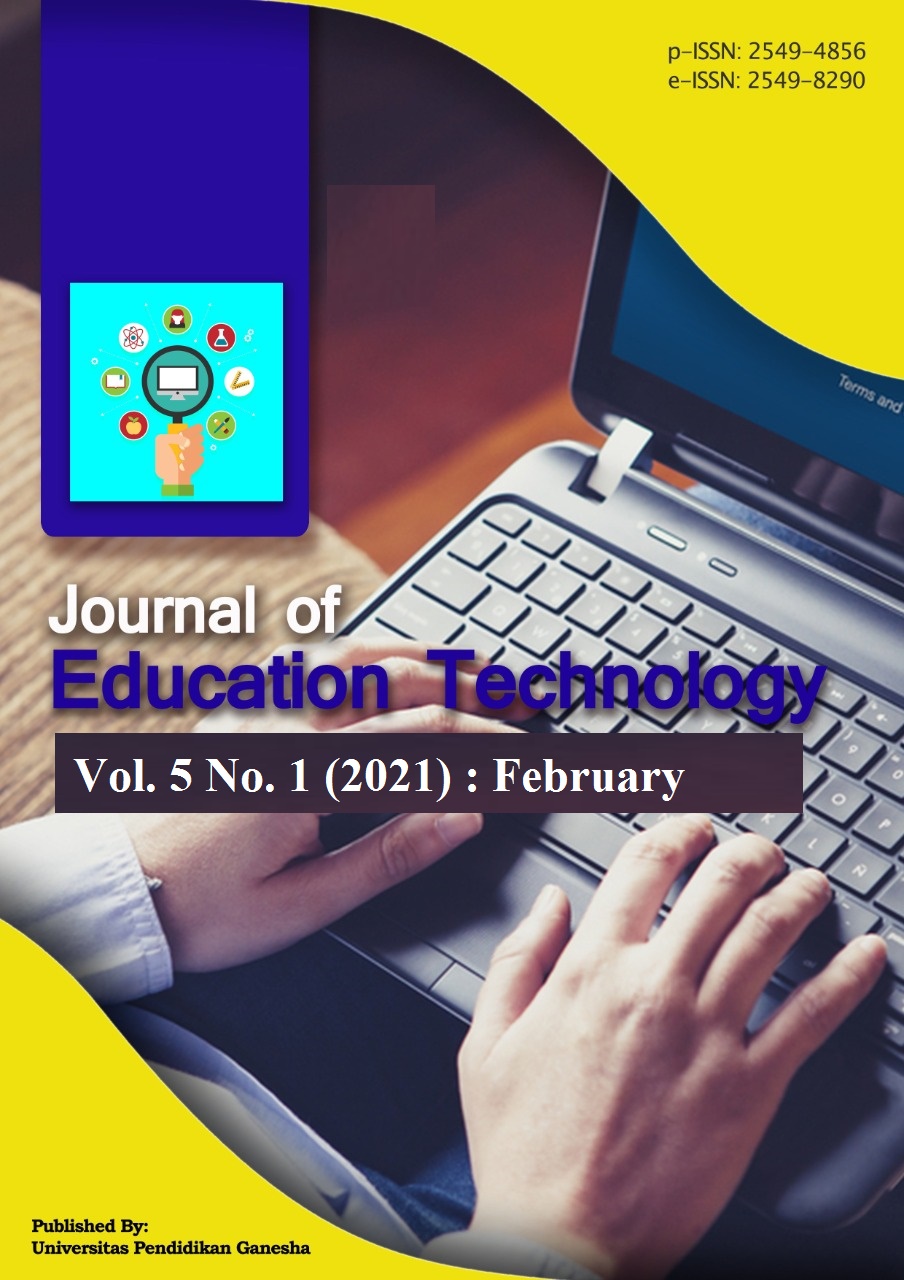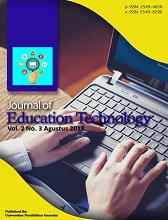Video Tutorials on Education Statistics Course Assisted with Screencastify: Validity and Feasibility
DOI:
https://doi.org/10.23887/jet.v5i1.33630Keywords:
instructional videos, screencastifyAbstract
The students' difficulty understanding lecture material is due to the lack of learning media that can help students learn independently. This study aims to develop a learning video tutorial based on the Screencastify screen record. This type of research is developmental research. The development model used is the Plomp development model. The development of the learning model is divided into three stages, namely the initial research, the prototype production, and the model assessment stage. The technique of collecting data in this research is observation and interview. The instrument used to collect data was a questionnaire. Data analysis was carried out to know the feasibility or validity of the product being developed. Media testing uses expert judgment. The validity measurement uses the Likert scale. The results of the validity and practicality of the validators were carried out by using the Intraclass Correlation Coefficient (ICC) test using the SPSS program. The results showed that the educational statistics tutorial videos were classified as valid for all categories and very practical, with a score of 85.5 based on students' answers as respondents. It can be concluded that the learning video developed is valid so that it is feasible to be applied in the learning process.References
Coal, HH, & Coal, DS (2020). Use of Video Tutorials to Support Online Learning During the Corona Virus Pandemic. Muallimuna: Journal of Madrasah Ibtidaiyah, 5 (2), 21. https://doi.org/10.31602/muallimuna.v5i2.2950
Busyaeri, D. (2016). The Effect of Using Learning Videos on the Improvement of Science Subjects Learning Outcomes in Min Kroya Cirebon. Al Ibtida: Journal of MI Teacher Education, 3 (1). https://doi.org/10.24235/al.ibtida.snj.v3i1.584.
Christian, CM (2010). Examining Chemistry Students Visual-Perceptual Skills using the VSCS tool and Interview Data. North Carolina State University.
Colvin Clark, R., & Mayer, RE (2011). . E-learning and the science of instruction; Proven guidelines for consumers and designers of multimedia learning (3rd ed.). San Francisco: John Wiley and Sons.
Febriana. (2017). The Effectiveness of Competency-Based Learning Model with the World of Work Approach in the D3 Catering Program. Educational Horizons, 36 (1), 148–155. Retrieved from https://journal.uny.ac.id/index.php/cp/article/view/8891/pdf
Imama, N. (2012). Improving Science Learning Outcomes through Constructivism-Based Cooperative Learning Combined with Animated Videos of Plant Life Systems Material. Indonesian Science Education Journal, 1 (1). https://doi.org/https://doi.org.10.15294/jpii.v1i1.2010.
Khamparia, A., & Pandey, B. (2017). Impact of interactive multimedia in E-learning technologies: Role of multimedia in E-learning. Enhancing Academic Research With Knowledge Management Principles, (April), 199–227. https://doi.org/10.4018/978-1-5225-2489-2.ch007
Krishna, IPDM, Sudhita, IWR, & Mahadewi, LPP (2015). Development of Learning Video Media in Ipa Subjects for Class VIII Even Semester Students. E-Journal Edutech Ganesha University of Education Department of Educational Technology, 3 (1). https://doi.org/http://dx.doi.org/10.2387/jeu.v3i1.5701
Krisna, NLPG, D, IWR, & Abadi, IBGS (2013). The Influence of the Contextual Video-assisted Quantum Learning Model on Science Learning Outcomes of Students at SDN 2 Dangin Puri. MIMBAR PGSD Undiksha, 1 (1). https://doi.org/http://dx.doi.org/10.23887/jjpgsd.v1i1.1261.
Kurtz, G., Tsimerman, A., & Steiner, O. (2014). The Flipped Classroom Answer to Future Learning? European Journal of Open, Distance and E-Learning, 17 (2). https://doi.org/https://doi.org/10.2478/eurodl-2014-0027
Maryati, I. (2017). Improving junior high school students' statistical reasoning abilities through contextual learning. Mosharafa Journal, 6 (1), 129–140.
Naharir, RA, Dantes, N., & Kusmariyatni, N. (2019). The Influence of the Learning Model of Course Review Horay Assisted by Learning Video Media on the Mathematics Learning Outcomes of Class V Semester Ii SD Cluster Vi, Sukasada District. MIMBAR PGSD Undiksha, 7 (1). https://doi.org/http://dx.doi.org/10.23887/jjpgsd.v7i1.16975
Novita, Sukmanasa, & Pratama. (2019). The Use of Video Learning Media on Primary School Student Learning Outcomes. Indonesian Journal of Primary Education, 3 (2), 64–72. https://doi.org/https://doi.org/10.17509/ijpe.v3i2.22103
Partayasa, W. (2020). The Effect of Learning Model Creative Problem Solving (CPS) Assisted by Video Learning on Problem Solving Ability in terms of Interests. JNPM (National Journal of Mathematics Education), 4 (1), 168. https://doi.org/10.33603/jnpm.v4i1.2644
Plomp, T. & Nieveen, N. (nd). ). Educational design research. Enchede: Netherlands Institute for curriculum development.
Purwanti, B. (2015). Development of Mathematics Learning Video Media with Assure Model. Journal of Educational Policy and Development, 3 (1), 42–47. https://doi.org/https://doi.org/10.22219/jkpp.v3i1.2194
Putra, PDA, & Sudarti. (2015). Development of E-Learning Systems to Improve Critical Thinking Skills of Physics Education Students. Indonesian Journal of Physics, 19 (55), 45–48. https://doi.org/https://doi.org/10.22146/jfi.24373
Qumillaila, Susanti, & Zulfiani. (2017). Development of Android Version Augmented Reality as Learning
Molli Wahyuni1, Adityawarman Hidayat2, Zulhendri3, Nurhizrah Gistituati4 (2021). Journal of Education Technology. Vol. 5(1) PP. 86-93
Video Tutorials on Education Statistics Course Assisted with Screencastify: Validity and Feasibility 93
Media for Human Excretion System. Educational Horizons, 34 (1), 57–69. Retrieved from https://journal.uny.ac.id/index.php/cp/article/view/9786/pdf. % 0A
Rahmi, MSM, Budiman, MA, & Widyaningrum, A. (2019). Development of Macromedia Flash 8 Interactive Learning Media on Thematic Learning in My Experience Theme. International Journal Of Elementary Education, 3 (2), 178–185. https://doi.org/10.23887/ijee.v3i2.18524
Redhana, IW (2019). Developing 21st Century Skills in Learning Chemistry. Journal of Chemical Education Innovation, 13 (1), 2239–2253. Retrieved from https://journal.unnes.ac.id/nju/index.php/JIPK/article/view/17824.
Rosy, B., Ranu, ME, Nugraha, J., & Handini, HT (2018). E-Learning Based Learning Media Training, Schoology for Vocational School Teachers in Office Administration Expertise Program in Jombang Regency, East Java. Journal of Civil Society Empowerment, 2 (2). https://doi.org/https://doi.org/10.21009/JPMM.002.2.02
Sariningsih, R., & Purwasih, R. (2017). Learning Problem Based Learning To Improve Mathematical Problem Solving Ability And Self Efficacy Of Prospective Teacher Students. National Journal of Mathematics Education, 1 (1), 163–177.
Taqiya, Nuroso, & Reffiane. (2019). The Influence of Integrated Learning Model Type of Connected Assisted by Animated Video Media. Undiksha PGSD Platform, 7 (3), 289–295. https://doi.org/http://dx.doi.org/10.23887/jjpgsd.v7i3.19492
Tegeh, Simamora, & Dwipayana. (2019). Development of Learning Video Media with 4D Development Models in Hindu Religion Subjects. Undiksha Knowledge Base, 24 (2), 158–166. https://doi.org/http://dx.doi.org/10.23887/mi.v24i2.21262
Waller, V., & Wilson, J. (2001). A Definition for E-Learning. Newsletter of Open and Distance Learning Quality Control.
Widjiningsih, Sugiyono, & Gafur. (2014). Effectiveness and Efficiency of Video-Assisted Draping Techniques Learning in Higher Education. Educational Horizons, 1 (33), 62–70. Retrieved from https://journal.uny.ac.id/index.php/cp/article/view/1862/pdf33
Wisada, PD, Sudarma, IK, & Yuda S, AIWI (2019). Development of Character Education-Oriented Learning Video Media. Journal of Education Technology, 3 (3), 140. https://doi.org/10.23887/jet.v3i3.21735
Yuliani, Antara, & Magta. (2017). The Effect of Learning Videos on the Beginning Counting Ability of Group B Children in Kindergarten. Undiksha Age Education Journal, 5 (1), 96–106. https://doi.org/http://dx.doi.org/10.23887/paud.v5i1.11309.
Yusnia, Y. (2019). The Use of Video Scribe Media in Learning Science Literacy for PGPAUD Students. Cakrawala Dini: Journal of Early Childhood Education, 10 (1), 71–75. https://doi.org/https://doi.org/10.17509/cd.v10i1.17436
Downloads
Published
How to Cite
Issue
Section
License
Authors who publish with the Journal of Education Technology agree to the following terms:
- Authors retain copyright and grant the journal the right of first publication with the work simultaneously licensed under a Creative Commons Attribution License (CC BY-SA 4.0) that allows others to share the work with an acknowledgment of the work's authorship and initial publication in this journal.
- Authors are able to enter into separate, additional contractual arrangements for the non-exclusive distribution of the journal's published version of the work (e.g., post it to an institutional repository or publish it in a book), with an acknowledgment of its initial publication in this journal.
- Authors are permitted and encouraged to post their work online (e.g., in institutional repositories or on their website) prior to and during the submission process, as it can lead to productive exchanges, as well as earlier and greater citation of published work. (See The Effect of Open Access)


















